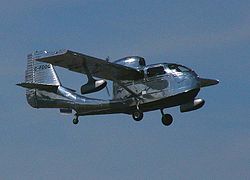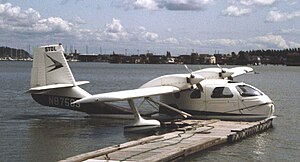Republic Seabee
The Republic Seabee is an all-metal amphibious small aircraft. It was designed by Percival Spencer and manufactured by the Republic Aviation Company .
| Republic RC-3 Seabee | ||
|---|---|---|

|
||
| description | ||
| task | All-metal amphibious aircraft, civil | |
| Manufacturer | Republic Aviation Company | |
| Unit cost | $ 6000 (1946), $ 60,000 + (2006) |
|
| First flight | December 1, 1945 | |
| crew | 1 pilot, 3 passengers | |
| Dimensions | ||
| length | 8.5 m | |
| height | 3.1 m | |
| span | 11.5 m | |
| Wing area | 18.2 m² | |
| Performance data | ||
| Empty mass | 993 kg | |
| Max. Takeoff mass | 1,429 kg | |
| Top speed (v ne ) |
129 knots / 238 km / h |
|
| Cruising speed (v c ) |
90 knots / 166 km / h |
|
| Stall speed with flaps (v S0 ) | 50 knots / 93 km / h |
|
| Range | 850 km | |
| Service ceiling | 12,000 ft / 4,000 m |
|
| Rate of climb | 700 ft / min | |
| Take-off distance at maximum load |
244 m (land) 305 m (water) |
|
| Original engines | ||
| 1 × Franklin 6A8-215-B8F or 1 × Franklin 6A8-215-B9F |
6-cylinder boxer engine, air-cooled, 215 hp at 2500 rpm | |
origin
The Seabee is a design by Percival Spencer , an aviation pioneer who built his first hang glider shortly after his 17th birthday in 1911. At that time he used plans from the magazine " Popular Mechanics ". On May 15, 1914, he made his first powered flight in a Curtiss Flying Boat. Perhaps this justified his interest in amphibious aircraft concepts, which led to the development of the Seabee.
In 1937, together with the Sikorsky engineer Vincent A. Larsen , he designed the first purely amphibious aircraft, the Spencer-Larsen SL-12C. However, the development of the aircraft was very slow. In September 1940 Spencer ended the collaboration and dedicated himself to his own company. His first aircraft was the Spencer S-12 Air-Car-Amphibian.
Development of the S-12 began in early March 1941, and the small, two-seater S-12 (NX29098) made its maiden flight on August 8, 1941. The S-12 is a fabric-covered shoulder-wing amphibious construction in a unique box construction, with a pusher propeller drive and a long, narrow stern fuselage.
In December 1941, Spencer put the S-12 aside to aid the war effort as a test pilot for the Republic Aviation Company. By 1943 he tested a total of 134 P-47 Thunderbolt . In April 1943, Spencer left the Republic Aviation Company to join the Mills Novelty Company of Chicago, Illinois, which wanted to use his S-12 for promotional purposes. Spencer used the company's wood manufacturing facilities to build a new, egg-shaped cabin for the S-12 and introduced the aircraft to his former employer, the Republic Aviation Company. Recognizing the machine's potential as the perfect sport aircraft, Republic bought the plans in December 1943 and immediately began developing an all-metal version, the RC-1 model. The first RC-1 (NX41816) made its maiden flight on November 30, 1944 with Spencer as test pilot.
The plane was demonstrated in St. Louis, Missouri, that December, and by the end of 1944 Republic had already received 1,972 civil orders for the $ 3,500 plane. The aircraft was also shown to the Navy and Army Air Corps. Both departments liked the design, and on February 19, 1945, the Navy granted the Republic Aviation Company the right to use the name "Seabee" for the civilian version. The army placed a large order for the aircraft, which from then on was used for air rescue under the designation OA-15. After the defeat of Japan in September 1945, however, the army and navy withdrew their orders. The OA-15 Seabee was the penultimate USAAF aircraft that received the designation "OA" (for observation, amphibian ).
production
On November 22, 1945 the prototype RC-3 Seabee (NX87451) left the production of the Republic Aviation Company in Farmingdale, New York, and completed its maiden flight on December 1, again with Spencer as test pilot. On December 27, 1945 Republic bought air-cooled engines from the manufacturer of Franklin Aircraft for the production version of the RC-3 Seabee.
Production of the RC-3 Seabee (NC87457, formerly NX87457) began in March 1946, and on July 25, 1946 the first Seabee (NC87463, Production No. 13) was sold to JG Rankin of Rankin Aviation Industries in Tulare, California, delivered. In the late 1940s, aircraft builders hoped that former military pilots would use the civil aircraft as a sports machine. This never happened to the extent that the companies imagined, since most of the returning war pilots gave up flying. As a result, many small sports machine manufacturers disappeared from the market after the war years.
On October 4, 1947, the Republic Aviation Company announced that it would cease production of the RC-3 Seabee for the civilian market. Republic President Mundy I. Peale stated: "Since Republic's production facilities are needed to manufacture other types of aircraft, the company has decided to discontinue production of the Seabee." In fact, by the summer of 1947, sales of the Seabee were almost complete stagnated and production has only been temporarily stopped since June 1947 in the hope of further sales. A remarkable 1060 Seabees should have been built by the end of production.
Although this was far from the hoped-for 5000 Seabees per year, it represented a significant number of aircraft compared to the numbers of other sports machine manufacturers. This was largely due to the low price of the Seabee. Only Piper with their inexpensive, durable Cub and Supercub, the Beech Bonanza and Cessna's early 140s and 150s models sold better than the Seabee. However, during production, the Seabee rose from its original $ 3,500 to $ 4,495 in July 1946, and hit $ 6,000 in November 1946. This resulted in declining sales of the four-seater all-metal amphibian. The civil aircraft market had been overestimated; Republic was supposed to sell its last new Seabee in 1948. So they focused their attention back on the military market and developed the very successful Republic F-84 Thunderjet , which was produced on the former production lines of the Seabee.
business
The Seabee became very popular in the United States and Canada. It was ideal for operating in countries with long coastlines, many islands, lakes and wilderness. Before production ended, 108 Seabees had been exported to Argentina, Brazil, Chile, England, France, Israel, India, Mexico, Norway, Sweden and Uruguay, and branch offices were opened in Brazil, Cuba, Panama, Colombia, Mexico, Uruguay, Peru, Venezuela, Chile, Argentina, Fiji, New Caledonia, South Africa, England, Norway and Sweden.
In the late 1940s and 1950s, the Seabee was one of the most popular ambulance and bush aircraft in Canada, Norway, Sweden and the United States. Many life-saving missions have been flown by Seabee pilots rescuing the seriously injured from remote islands and deep wilderness, and delivering supplies to hunters and trappers with impossible take-offs and landings on small lakes. A Seabee won film honors in 1974 in the James Bond thriller " The Man with the Golden Gun ".
In 2006 there were still over 250 Seabees registered worldwide, a number that is increasing every year as new aircraft are assembled from parts of wrecks. Some Seabees are still in commercial use as bush planes and air taxis. In the history of aviation, few aircraft have had longer or more successful careers than the Seabee.
Modifications
Today, modernized and restored versions of the Seabee are mostly equipped with more modern engines ( Lycoming , Corvette , Robinson) and components made of carbon fiber reinforced plastic . The instrumentation is also often state-of-the-art.
In the years 1965–1988, 23 Seabees were converted into a twin-engine STOL variant, which is equipped as the STOL Aircraft Corporation UC-1 Twin Bee with two twin-blade traction propellers (2 × Lycoming with 180 hp each) integrated into the wings. It has a hull that is 90 cm longer than the RC-3, an additional 1.80 m wingspan and can accommodate a total of 5 people. The additional thrust increases the performance of the aircraft in terms of acceleration, rate of climb, speed and capacity.
Furthermore, there are modifications and replicas that are based on the construction of the Seabee or are strikingly similar:
- Republic OA-15 Seabee (military version of the RC-3)
- STOL Aircraft Corp. UC-1 Twin Bee
- Trident TR-1 Trigull
- Nardi / Siat- Marchetti FN.333 Riveria
- Republic RC-1 Thunderbolt Amphibian
- Colonial skimmer
- Lake Amphibian
- Thurston TRC-1 Teal
Web links
- International Republic Seabee Owner's Club
- Seabee restoration and maintenance
- The Seabee, History and Modifications
- Seabee Photo Tour
- The Robinson V-8 Seabee engine



